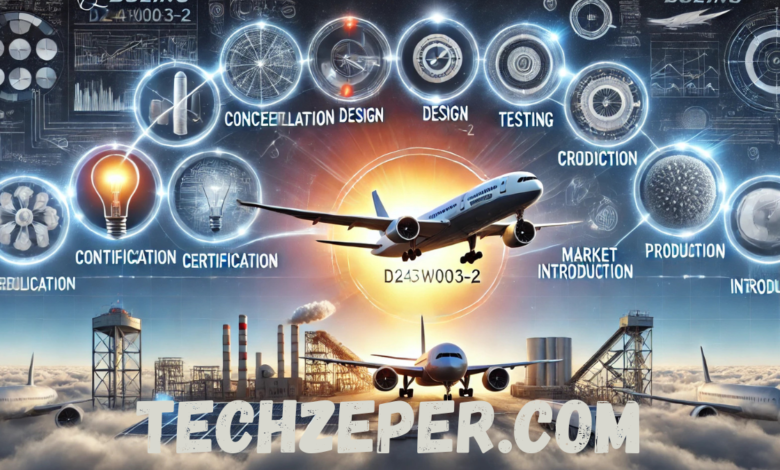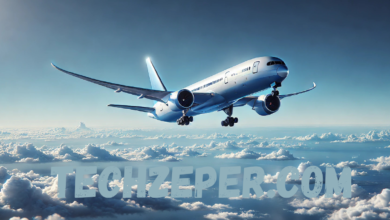From Concept to Sky: The Comprehensive Journey of Boeing D243W003-2

Introduction
Developing a new aircraft in the aerospace industry is a monumental feat, embodying the pinnacle of engineering, innovation, and collaborative efforts across numerous fronts. Boeing’s D243W003-2 is a vivid illustration of such an endeavor. This article will delve deeply into the entire lifecycle of the Boeing D243W003-2, from its inception and design to its production, testing, market introduction, and broader implications on the future of aviation.
1. Ideation and Conceptualization
Thestory of the Boeing D243W003-2 begins with the identification of a gap in the commercial aviation market. Boeing aimed to create an aircraft that addressed global airlines’ current needs for fuel efficiency, reduced operational costs and preempted regulatory trends toward lower emissions. This initial phase involved extensive consultations with stakeholders, potential customers, and regulatory bodies, ensuring the aircraft would be competitive and compliant.
2. Groundbreaking approaches to aerodynamics, materials science, and propulsion systems marked design and EngineeringThe design phase of the D243W003-2.
The engineering team chose advanced composite materials for the airframe, which decreased the aircraft’s overall weight and enhanced fuel efficiency. Aerodynamic enhancements were applied to the wing design and tail configuration to optimize performance. Additionally, the propulsion team worked closely with engine manufacturers to develop an engine that complemented the aerodynamic efficiencies with superior fuel burn rates.
3. Advanced Avionics and Technologies
Central to the D243W003-2’s appeal are its cutting-edge avionics and cockpit technologies. The aircraft features an integrated avionics suite that enhances flight operations and safety through features like synthetic vision and advanced weather radar systems. Including AI-driven algorithms assists in predictive maintenance and operational analytics, allowing airlines to reduce unexpected downtimes and optimize flight schedules.
4. Prototyping and Initial Testing
The prototype of the Boeing D243W003-2 was assembled in Boeing’s state-of-the-art production facility, followed by a series of ground tests to validate its structural integrity and systems functionality. These tests included static airframe stress tests, systems integration trials, and taxi tests, but only after these exhaustive evaluations was the aircraft ready for its maiden flight.
5. Flight Testing and Certification
The D243W003-2 underwent a rigorous flight testing program, which is crucial for certification by aviation authorities like the FAA and EASA. This phase involved testing the aircraft under various operational conditions, including extreme weather and emergency scenarios. Each test assessed the aircraft’s systems and structures’ performance, safety, and reliability. After successful testing, the aircraft received its type certification, affirming its safety and airworthiness.
6. Production Scaling and Quality Assurance
Post-certification, the focus shifted towards mass production. Boeing implemented several advanced manufacturing techniques, including automation and robotics, to scale production while maintaining high-quality standards. Each unit of the D243W003-2 was subject to stringent quality checks to ensure that it met all design specifications and regulatory requirements.
7. Market Introduction and Commercial Success
The commercial launch of the Boeing D243W003-2 was strategically planned to align with significant aviation trade shows and airline peak buying cycles. Marketing efforts emphasized the aircraft’s innovative features, operational cost benefits, and environmental friendliness. The response from the airline industry was overwhelmingly positive, with numerous carriers placing bulk orders.
8. Impact on Global Aviation and Future Prospects
The introduction of the D243W003-2 has profoundly impacted the aviation sector, setting new standards for efficiency and sustainability. The aircraft has become a benchmark for future developments in aerospace technology, with ongoing research focusing on even more efficient engines and alternative fuels. The D243W003-2 also serves as a foundation for Boeing’s exploration into fully electric and hybrid aircraft, underscoring the company’s commitment to pioneering sustainable aviation technologies.
Conclusion
The journey of Boeing’s D243W003-2 from concept to sky is a testament to human ingenuity and the relentless pursuit of advancement in aviation technology. As this aircraft continues to serve airlines and passengers worldwide, its legacy will influence generations of aircraft design and innovation, steering the course toward a more efficient and sustainable future in aerospace development.
FAQs about Boeing D243W003-2
- What makes the Boeing D243W003-2 unique in the aviation market?
- The Boeing D243W003-2 distinguishes itself with advanced materials, superior aerodynamics, cutting-edge avionics, and a focus on sustainability, setting a new benchmark in commercial aviation.
- How does the Boeing D243W003-2 enhance fuel efficiency?
- The aircraft utilizes lightweight composite materials and a new wing design to minimize drag, coupled with highly efficient engines, substantially improving fuel efficiency.
- What are the key features of the D243W003-2’s avionics system?
- The avionics suite includes synthetic vision systems, advanced weather radar, and AI-driven predictive maintenance tools, enhancing safety and operational efficiency.
- What was involved in the testing phase of the D243W003-2?
- The testing phase included ground tests, taxi tests, and a comprehensive flight testing program to ensure the aircraft met all safety and performance criteria.
- How has the D243W003-2 influenced future aircraft development?
- The D243W003-2 has set new standards for efficiency and sustainability, influencing ongoing research and development in next-generation aircraft technologies, including hybrid and electric propulsion systems.
You May Also Read: https://techzeper.com





